
P. cooperi growing with P. leiophylla [C.J. Earle, 2007.02.10].
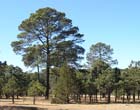
Growing with Juniperus deppeana [C.J. Earle, 2007.02.10].
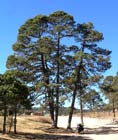
Large trees [C.J. Earle, 2007.02.10].
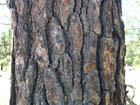
Bark of a 50 cm diameter tree [C.J. Earle, 2007.02.10].
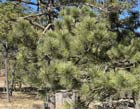
Branch, showing typical foliar units [C.J. Earle, 2007.02.10].

Mature cone in situ [C.J. Earle, 2007.02.10].
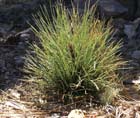
Larger seedling [C.J. Earle, 2007.02.10].
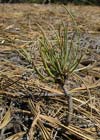
Seedling, 7 cm tall [C.J. Earle, 2007.02.10].

Conservation Status

Pinus cooperi
C.E. Blanco 1950
Common names
Pino de Cooper [Spanish], Cooper's pine.
Taxonomic notes
Syn: Pinus arizonica var. cooperi (C.E. Blanco) Farjon 1997; P. lutea Blanco ex Martínez 1945 non Walter 1788, nec Gordon & Glendinning 1858; P. lutea var. ornelasi Martínez 1945; Pinus cooperi var. ornelasii (Martínez) C.E. Blanco 1950 (Farjon and Styles 1997); P. arizonica subsp. cooperi (C.E. Blanco) Silba 2009. Type: Durango, El Salto, M. Martinez 3442.
Farjon and Styles (1997) assert that, as with the other varieties of P. arizonica, characters distinguishing the varieties vary continuously, thus treatment at the species rank is inappropriate. However, quite a few Mexican pine species are not clearly distinguishable from their close relatives, due to processes such as hybridization and ongoing species differentiation, so this argument is rejected by some Mexican botanists and the name Pinus cooperi is in fairly common use in the literature. Moreover, molecular studies have clearly shown that it is not particularly closely related to P. arizonica; see the "Taxonomic notes" for Pinus ponderosa for further discussion.
The name "var. ornelasii" was attributed by Martínez to a 5-leaved form with dark green, longer needles and larger cones, but Farjon and Styles (1997) found these differences to be inconsistent (sometimes larger cones and normal needles, or longer needles and unusually small cones) and reduced the variety to synonymy.
Description
Trees to 35 m tall and 80 cm dbh, with a pyramidal, open crown of large, thick, pendant branches. Bark on mature trees rough, thick, reddish brown, with longitudinal and transverse fissures forming a network of scaly polygonal plates. Twigs relatively thick and stiff, brown, with prominent, decurrent leaf bract bases. Leaves in fascicles of (4-)5, thick, stiff, 8-10(-14) cm long, margins finely serrate, stomata on all surfaces; resin canals (3-)4-5(-7), medial. Fascicle sheaths persistent, 10 mm long. Seed cones nearly symmetrical, ovoid, 6-10 cm long, 6 cm across when fully opened, light red-brown, borne in 1's and 2's on stout peduncles to 5 mm long that remain attached to the cone when it falls. Cones open upon maturity and are somewhat persistent. Cone scales thin, flexible, with flat to slightly thickened apophyses, the umbo bearing a small, recurved, persistent prickle. Seeds brown, 5-7 mm long with a 5-8×12-20 mm wing. Sapwood yellow, heartwood pinkish brown (Perry 1991). See García Esteban et al. (2004) for a detailed characterization of the wood anatomy.
Perry (1991) distinguishes P. cooperi from the similar species P. arizonica and P. durangensis by its smaller, thinner bark plates; thinner, flexible cone scales with a small, flattish umbo; peduncle that falls with the cone; and predominately 5-leaved fascicles.
Distribution and Ecology
Mexico: Chihuahua and Durango. May form pure stands, but commonly found with P. durangensis, P. leiophylla, P. strobiformis and P. teocote, as well as with junipers (J. flaccida at lower elevations, J. deppeana at higher), or species of Quercus (Farjon and Styles 1997). Also see Thompson et al. (1999). Hardy to Zone 7 (cold hardiness limit between -17.7°C and -12.2°C) (Bannister and Neuner 2001).
Distribution data. Red indicates observations of Pinus arizonica sensu latu, which may include some observations of P. cooperi and P. stormiae. P. arizonica is shown in orange, P. stormiae in blue, and P. cooperi in yellow. Data sources include my observations, Farjon & Styles (1997), and downloads from GBIF (2014) and SEINet (2014).
Remarkable Specimens
Ethnobotany
In dendrochronology, the species has been used in at least one dendroclimatic reconstruction (Pompa-Garcia and Jurado 2013). This work, using chronologies developed at two sites, found that ring width was highly correlated with total precipitation during the previous winter.
Observations
It is very common along MEX-40 from Durango to Mazatlan, in the vicinity of El Salto, where it forms extensive pure stands.
Remarks
P. cooperi is a principal host for the dwarf mistletoes Arceuthobium globosum subsp. globosum, Arceuthobium rubrum, A. vaginatum subsp. vaginatum, and A. verticilliflorum (Hawksworth and Wiens 1996).
I find this to be one of the most impressive of Mexican pines. Although individual trees do not approach the size of some other species (such as Pinus montezumae), the parklike forests of large, tall trees, covering the landscape over tens or hundreds of square kilometers, is a sight rarely encountered in the arid, heavily utilized forests of Mexico. These forests, which invite a walk or a drive through them, may be one of the reasons why so many westerns have been filmed around Durango.
Citations
Blanco, C. E. 1950. Pinus cooperi Blanco, sp. nova. Anales Inst. Biol. Univ. Nac. México 20:183-187.
Farjon, Aljos. Pinus arizonica var. cooperi. P.107 in Farjon and Styles (1997).
Pompa-García, Marín, and Enrique Jurado. 2013. Seasonal precipitation reconstruction and teleconnections with ENSO based on tree ring analysis of Pinus cooperi. Theoretical and Applied Climatology. DOI 10.1007/s00704-013-1018-6.
Silba, John. 2009. Journal of the International Conifer Preservation Society 16(1):14.
See also
Corral, R.J., J.G. Álvarez González, A. Ruíz González, and K.V. Gadow. 2004. Compatible height and site index models for five pine species in El Salto, Durango (Mexico). Forest Ecology and Management 201:145–160.








